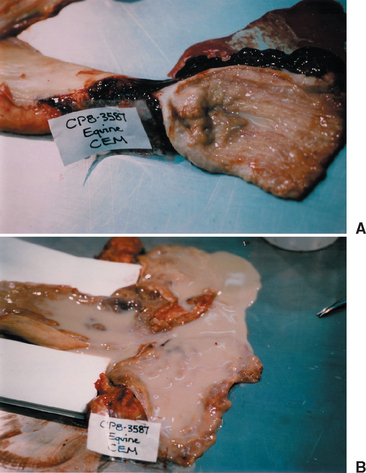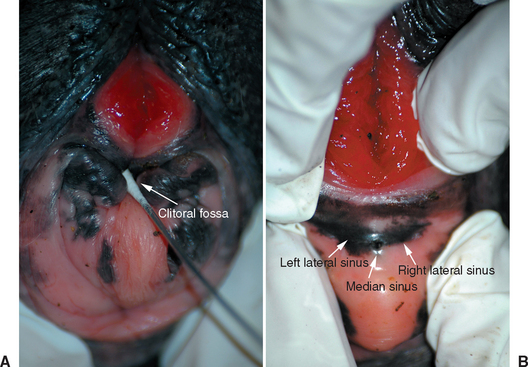CHAPTER 41 Contagious Equine Metritis
EPIDEMIOLOGY
CEM was first reported in 1977 in Newmarket, England,1 and spread rapidly among horses in Europe. Two carrier Thoroughbred stallions imported from France are thought to have introduced the disease into the United States (U.S.) in 1978.2 CEM is transmitted by either carrier stallions or mares during mating.
PATHOGENESIS AND CLINICAL FINDINGS
Infected stallions do not show clinical signs and are inapparent carriers of the bacteria on external genitalia.3 The bacteria may persist for an extended period and are most frequently isolated from the fossa glandis and urethral sinus. The organism can also be isolated from the distal end of the urethra, the prepuce, and surface of the penis.4 Schluter et al.5 isolated T. equigenitalis from the urethra, testis, epididymis, and seminal vesicles of an infected stallion at postmortem, suggesting T. equigenitalis may be transmitted through seminal fluid.
Taylorella equigenitalis causes temporary infertility in the mare. The acutely infected mare does not usually conceive. If pregnancy is successful, mares can abort or produce foals at term that are also carriers. Clinical signs in infected mares range from copious purulent vaginal discharge (Fig. 41-1, A) for up to 14 days after mating to shortened diestrous intervals unaccompanied by other clinical signs.3 Typically, T. equigenitalis causes an intense neutrophilic endometritis (Fig. 41-1, B) that subsequently resolves with a subacute neutrophilic mononuclear endometrial response.6 Some mares recover spontaneously, whereas a smaller percentage of mares become chronic carriers, with the bacteria localizing most often in the clitoral sinuses and fossa and occasionally in the uterus.3
DIAGNOSIS AND IMPORT REQUIREMENTS
Horses may be imported into the U.S. from CEM-infected countries after meeting preimport requirements and testing negative for dourine, glanders, equine piroplasmosis, and equine infectious anemia at the port of entry into the U.S. Additionally, mares and stallions over 731 days of age are required to go through further test procedures for CEM at a state-approved CEM quarantine facility.7 Tests are carried out by an accredited veterinarian under supervision by either state or federal officials.
At the CEM quarantine facility, swabs are taken from the mare’s clitoral fossa (Fig. 41-2, A) and sinuses (Fig. 41-2, B) on three occasions 3 days apart for bacterial culture of T. equigenitalis. On the third culture, the clitoral sinuses are flushed with a cerumenolytic agent (Cerumene, Evsco Pharmaceuticals, Buena, NJ) and 0.2% nitrofuracin solution (Equi-Phar Nitrofurazone, Squire Laboratories, Revere, Mass) and packed with 0.2% nitrofuracin ointment. The area is subsequently scrubbed with 4% chlorhexidine gluconate (Betasept, Purdue Frederick, Norwalk, Conn) and packed with 0.2% nitrofurazone ointment for 4 more days. Mares testing positive for CEM have the option of being returned to the country of origin or undergoing treatment.
For stallions, three separate swabs are obtained from the prepuce and surface of the penis (Fig. 41-3, A), the fossa glandis (Fig. 41-3, B) and the urethral sinus (Fig. 41-3, C). If the stallion is negative for T. equigenitalis, the stallion is subsequently mated to two test mares (Fig. 41-4), and the stallion’s external genitalia are scrubbed for 5 days with 4% chlorhexidine gluconate and packed with 0.2% nitrofurazone ointment. Three sets of cultures are taken from the stallion’s test mares’ clitoral sinuses and fossa at 3, 6, and 9 days after mating, and one intrauterine sample is taken from each mare 3 to 9 days after mating. A complement fixation (CF) test for CEM is performed on each test mare at 15 and 20 days after mating. Stallions testing positive for CEM have the option of being returned to the country of origin, castrated, or treated.
Stay updated, free articles. Join our Telegram channel

Full access? Get Clinical Tree




